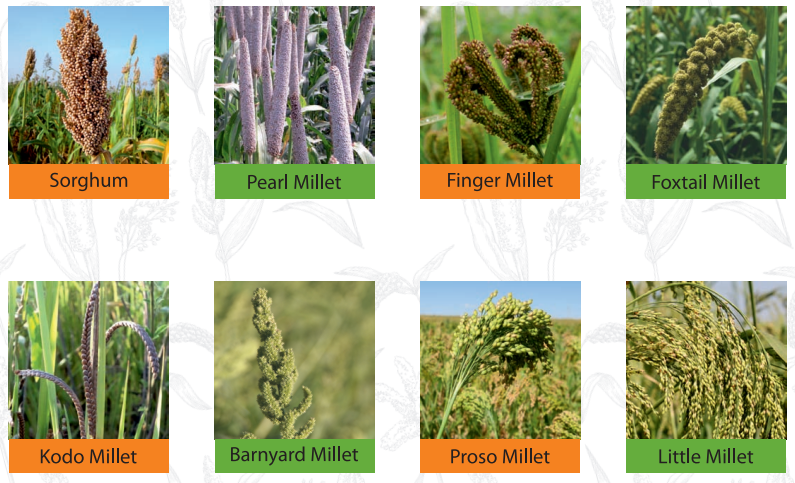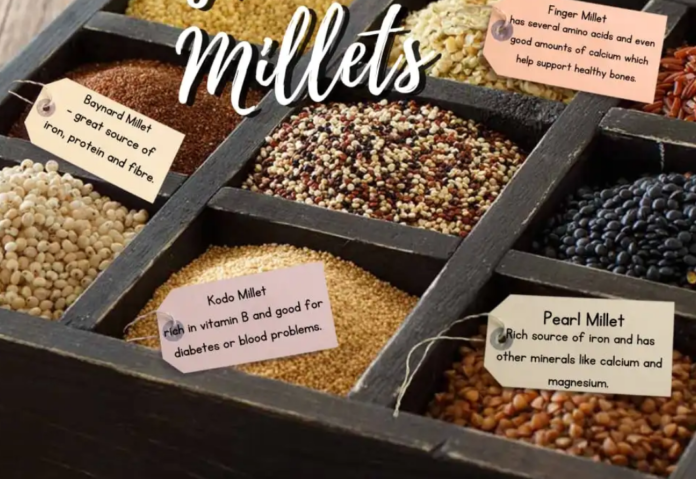We’ve all heard the old saying “You are what you eat”, and it’s still true. A balanced nutritive diet is the mantra to good health. In recent times people are becoming conscious of the consumption of balanced and nutritional diet leading to a healthy lifestyle. Millet grains have been the traditional component of food basket in India. So why not include it in the daily diet, eat right and stay healthy !
Millets are a traditional staple food of the dry land regions of the world. They are nutri-cereals which are highly nutritious and are known to have high nutrient content which includes protein, essential fatty acids, dietary fibre, B-Vitamins and minerals such as calcium, iron, zinc, potassium and magnesium. They help in rendering health benefits like reduction in blood sugar level (diabetes), blood pressure regulation, thyroid, cardiovascular
and celiac diseases.
These are one of the oldest foods known to humanity. These are one of the several species of coarse cereal grasses in the family Poaceae, cultivated for their small edible seeds. They are highly nutritious, non-glutinous and not acid forming foods. Hence they are soothing and easy to digest.
Why 2023 is the year of millets
Once a forgotten staple of traditional Indian cuisine, nutritionally dense millets are becoming popular the world over. So much so that 2023 is being dubbed “the year of millets”.
Millets are a group of small grains – technically seeds – that are grown on lands with poor soil quality or limited access to irrigation. They are versatile ingredients that can be used both in their original grain form in porridges and as rice substitutes, or as flour to make flatbreads and other baked goods.
Types of millets
 There are several types of millets. The six best millets known for their amazing health benefits include:
There are several types of millets. The six best millets known for their amazing health benefits include:
Finger millet (Ragi)
Sorghum (Jowar)
Pearl millet (Bajra)
Foxtail millet (Kangni)
Barnyard millet (Samvat ke chawal)
Little millet (Kutki)
Health Benefits Of Millets
Regulate Blood Glucose Levels
Millets, when compared to wheat and maize, are high on nutrients, gluten-free and have a low glycemic index of 54-68. The presence of a high amount of dietary fibre, proteins with all essential amino acids, vitamins, and minerals helps in stabilizing the blood sugar levels. Millets can be a part of a healthy diet for diabetic patient that prevent blood sugar spikes and promote insulin sensitivity.
Help In Weight Loss
Millets are boon for all weight watchers who are wanting to shed those extra kilos. Including millets in the regular regimen like millet flour or having millets for breakfast can remarkably help in lowering the BMI of obese people. Swapping rice with millets daily can lower accumulation of fat, improves gut health and help you in achieving sustained weight loss.
Good For Heart
Millets are loaded with an impressive profile of antioxidants that include beta-glucans, flavonoids, anthocyanidins, tannins, lignans, and policosanols. These antioxidants play a crucial role in lowering LDL cholesterol, total cholesterol and helps to maintain the blood vessels healthy and clears off the clots, thereby lowering the risk of heart disease, and stroke.
Battles Cancer Cells
Millets such as foxtail and proso varieties are `proven by research to be effective in inhibiting the growth of cancerous cells in various tissues. The Phytochemicals in millets exhibit antiproliferative effects and lower formation of cancer cells in the colon, breast, and liver without causing any damages to normal cells.
Promotes Digestion
The presence of a good amount of dietary fiber in millets works well to improve the digestive system function. It combats constipation, flatulence, bloating, cramping, regularizes the bowel function and improves the overall health of other vital organs like liver, kidney and boosts the immune system.
Millets are bestowed with a wealth of nutrients and fiber that supports boost metabolism, augment heart health, control blood pressure and diabetes and promote weight loss. Thus, they are a healthy addition to the meal plan. While it is also beneficial for the environment, as it mainly rain-fed crops, do not attract pests and can grow well without the use of pesticides.
Rich in heritage and full of potential, millets are a sustainable, nutritious and under-valued food source
Check out many delicious millet recipes here >>






